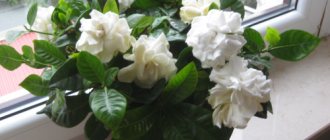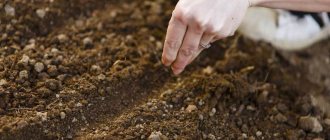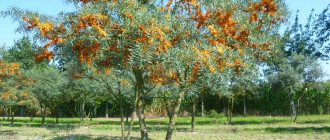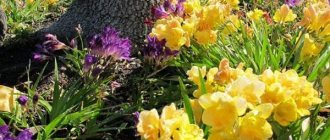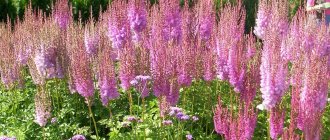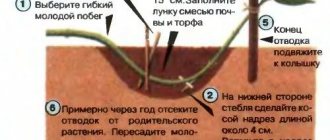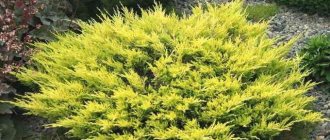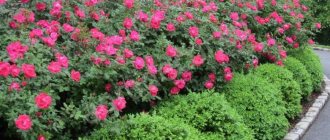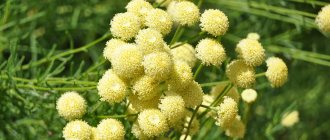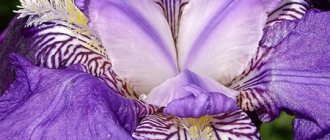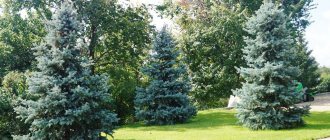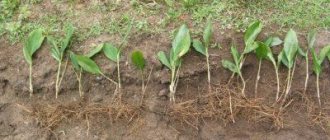Unlike deciduous trees, the appearance of conifers remains attractive at any time of the year, so many owners strive to decorate their site with this Christmas attribute. But before planting a spruce on the site, you should decide on the type of tree, choose the optimal location and properly prepare the soil at the dacha for planting the plant.
Choosing a Christmas tree variety
The main criterion when choosing the type of coniferous tree is the shape of the crown and the height of the adult plant.
When decorating a summer cottage, three varieties of fir trees are mainly used.
- Common spruce is a type of plant 1.2-3 meters high. The shade of the needles ranges from golden to bright green. This species can most often be found in the countryside.
- Gray spruce - got its name due to the grayish color of the tree bark and the gray-blue or ashy shade of the needles. Tall varieties of spruce have a cone-shaped crown, and in dwarf plants the top has the shape of a nest or ball.
- Prickly spruce is a tree with a decorative cone-shaped crown, sometimes reaching a height of 40 meters. Dwarf trees up to 2 m are less common. The needles of such spruce trees are very prickly and have a color from whitish-blue or silver to turquoise.
When choosing a spruce for a small dacha, you should choose a plant of medium or dwarf height, while tall ones are suitable for a country house with a large plot of land. When decorating garden plots, medium-sized or dwarf species are especially popular.
Popular types and varieties of spruce
The most popular spruce trees that summer residents grow in their gardens are the following:
- Common (European): Nidiformis;
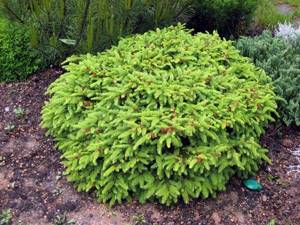
Nidiformis - Spiny (blue): Hoopsie, Glauka, Glauka Globoza;
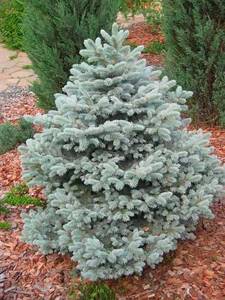
Glauka - Canadian (gray): Alberte Globe, Konika, Echiniformis;

Konika - Eastern: Golden Star;
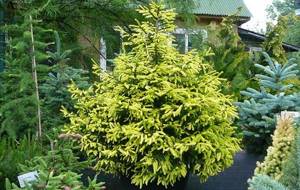
- Black: Nana.
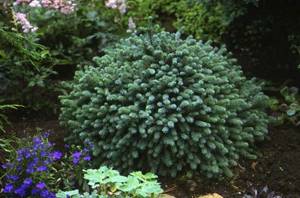
Video: types and varieties of spruce trees
By the way! growing the Canadian Konica spruce in one of the following articles, but for now you can watch the video below.
Video: how to properly plant and care for Canadian spruce
By the way! In general, there are no serious differences in growing different types of conifers, be it common, blue or Canadian spruce. That is why below we will present general instructions for planting and caring for spruce in a summer cottage.
Purchasing or searching for a seedling
You can start a Christmas tree in different ways. You can choose it from a nursery, bring it from the forest, or grow it yourself in a container.
- Nurseries sell mature trees, digging them up in the presence of the buyer, or offer spruce trees in containers. Trees whose root system is exposed may not survive until they are planted in the ground. Therefore, it is very important to choose a spruce with intact roots and a clod of earth that protects them from the effects of the external environment. It will be much easier to grow such a tree, since the tree will tolerate replanting well, will suffer less pain and adapt faster.
- If the type of tree does not matter, then you can bring a Christmas tree from the forest, choosing a tree from 1 to 2 meters. The tree should be dug up from all sides to remove it with a large lump of earth. Small trees can be transported from the forest with their roots exposed, but during transportation, cover them with tarpaulin material, and upon arrival immediately plant them in a prepared hole.
- To grow a seedling from a seed, you need to bring open cones from the forest in winter and collect the seeds. Add soil taken from the forest to the container for planting, or add soil mixture for coniferous plants. The seeds are planted in the ground to a depth of 5 mm and placed in a cool place.
During the warm season, the tree should be regularly moistened, and in cool times, reduce watering to twice every 30 days. To ensure periods of rest, the plant should be periodically placed on the balcony or in the yard. In one year, a spruce can grow up to 25 cm in height.
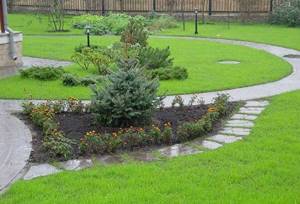
Reproduction
Seeds . Growing spruce trees by seed does not pose any particular difficulties. The seeds ripen in late winter or early spring. But you need to collect them early so that they don’t have time to spill out of the cone. Sow the seeds in boxes with soil prepared in the fall and place them outside. You can wait until the soil thaws and sow them in open ground. Seeds germinate in the year of sowing. But this method is acceptable only for species-specific spruce trees. Its numerous forms must be propagated by cuttings in order for all the characteristics of the variety to be transmitted.
From a cutting . Spruce is a difficult-to-root plant. The optimal time for cuttings is April-May, when the vegetative buds begin to swell. They are prepared from last year's shoots, tearing them off at the heel. It is desirable that the mother plant be no younger than 10 years old and no older than 30. The older the mother plant, the less chance of success.
It is better to take cuttings from the middle part of the crown . to low-growing and bushy forms of spruce ( nest-shaped, compact, Ohlendorf ). And the percentage of rooting in low forms is much higher than in other varieties . The cuttings treated with the stimulant are planted in peat-sand (1:2) or sandy substrate to a depth of 2-2.5 cm. For their rooting, shading from direct sunlight and frequent spraying of the needles from a fine sprayer is necessary. At the same time, excessive waterlogging of the soil should not be allowed, because this leads to rotting of the lower part of the cuttings. The required temperature is 22-28°C.
Spruce stalk with heel
By autumn, some of the cuttings take root , the rest form callus, and rooting will occur next year. The plants are left until next spring, and then planted in open beds for growing. It is advisable to slightly hill them up for the winter and shade them from the sun in early spring.
Selecting a location
Since spruce can reach a height of 10 m and a width of 5 m, you must carefully choose a planting site. Under natural conditions, the plant feels good near the river, where its root system can receive enough moisture. But the tree does not like wetlands, so caring for it involves arranging drainage.
Advice
Spruce greatly depletes the soil, so it cannot be planted next to fruit-bearing crops. In addition, it should be borne in mind that in adulthood, spruce is a fairly large tree. Therefore, it is not advisable to plant it under electrical wires.
Fir trees feel great surrounded by birch trees. They are not afraid of the shade that birch trees provide; on the contrary, it is even useful to them. Spruce is one of the rare trees that retains its beauty in the shade.
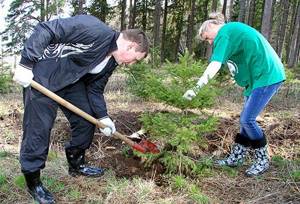
Digging up spruce
In the forest you can find and dig up small one-year-old fir trees. To carefully replant a tree, you should first dig around it. The circumference of the pit should be equal to the diameter of the lower branches, and the depth should be at least 0.5 m.
The roots of the plant must be carefully removed from the ground without shaking them off. Then place the spruce on a thick cloth and carefully pack it, marking the cardinal directions with colored tape. Load the tree and a bag of forest soil into a vehicle and transport it to the planting site, being careful not to damage the branches and root system during transportation.
The soil in the forest is different from that in the garden. Therefore, you need to take soil from the forest from the place where you dug up the Christmas tree.
All varieties of spruce love light soil. They grow poorly on heavy types of soil. Before planting the plant in poor soil, it is necessary to apply mineral fertilizer (about 100 grams).
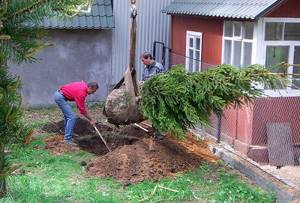
Planting a tree
The best time to plant spruce is spring or early autumn. At this time, the plant has already passed or has not yet entered the active growth phase. Coniferous trees grown in a container can be planted later, since their roots are not affected.
The size of the hole for planting the plant must match the volume of the earthen ball. For small plants 2–3 years old, a hole of 60 by 80 cm is sufficient, and if it is necessary to plant a large tree, the hole should be slightly larger than a ball of earth. The distance between the recesses for large plants should be three meters, for medium-sized ones - 3-5 m, and for dwarf plants from 0.5 to 1 m is sufficient.
Sequence of actions when landing
- Brick fragments are placed at the bottom of the dug hole to ensure drainage. Soil is poured on top. Forest soil mixed with humus is suitable for this purpose.
- The plant is placed in a hole along with a lump of earth. Under no circumstances should the root collar be buried in the soil; it should be correctly positioned flush with the surface of the earth.
- Carefully cover the roots with soil and compact lightly. It is important to maintain the original position of the tree relative to the cardinal directions when replanting. To do this, you need to make a mark on one of the sides of the tree, so that you can then navigate by this sign.
- The tree must be secured by tying it to two stakes, and an earthen roller must be made around the tree to retain irrigation water and form a circle near the trunk for laying mulch from chips and sawdust to protect it from frost, drying out and rodents.
- During the first time after planting, the seedling needs regular watering and care. In summer, the soil under the tree needs to be watered, but in winter there is no need to do this.
Mineral fertilizing should be introduced next spring. If the spruce planting is done correctly and proper care is provided, it will adapt fairly quickly.
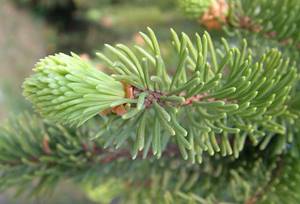
Caring for spruce in open ground at the dacha
Despite the fact that spruce trees require good lighting, young seedlings should be shaded in the first couple of years. This can be achieved either by planting a spruce seedling near the fence, or by pulling a special awning. This is especially dangerous in early spring, when the ground is still frozen, food does not reach the roots, that is, the conifer can simply burn.
Also, in the first 2 years, young conifers should be mulched with peat or sawdust for the winter. The mulch layer should be about 6-8 centimeters. A winter shelter will also not be superfluous . Mulch will also help retain moisture better.
The plant is not very demanding when it comes to watering , but in dry weather it needs frequent watering (about 1-3 buckets of water per week), especially for young trees. Moreover, it is advisable to pour water not directly under the trunk, but into the circle around the trunk. It is best to do this in the evening after sunset or early in the morning, but not in sunny time.
Advice! Coniferous plants also love and respond well to sprinkling irrigation , especially in dry summer weather.
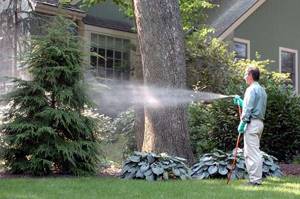
Another important stage in spruce care is weeding. Do not forget that the root system of the plant is quite high, so you should weed shallowly, about 5-10 centimeters.
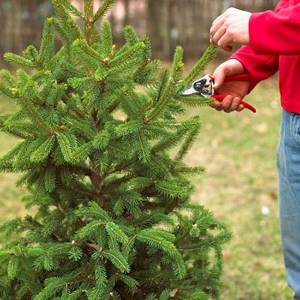
Coniferous plants do not require obligatory pruning haircuts should still be carried out (if desired)
Video: cutting Norway spruce and prickly spruce (blue)
As a rule, conifers are quite unpretentious and do not require additional fertilizing , but if you fertilize the spruce with compost, loosening the tree trunk, the plant will be very grateful to you and will definitely be noted for its more magnificent forms and rich color. As for mineral fertilizing, once a year you can sprinkle fertilizer in the tree trunk circle of the plant, and then water it generously with water. In general, there are special fertilizers for coniferous plants.
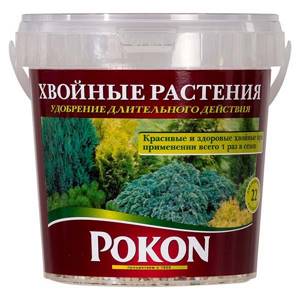
Important! Do not fertilize in the autumn, otherwise the plant will grow and may die due to the onset of frost.
Diseases
If the winter turns out to be warm and humid, then the conifer may contract a fungal disease. Periodic examinations of your garden pets and the use of various fungicidal preparations will help you cope with the scourge.
Coniferous plants are one of the favorite crops that you always want to have in your dacha, especially spruce. To ensure that the conifer meets your expectations and can withstand unfavorable conditions, pay attention to our advice and special recommendations for its planting and care.
Note! On our website you can also find detailed materials on planting and growing other conifers in the garden, for example, mountain pine , thuja and juniper .
Video: how to plant a coniferous plant (spruce) correctly
